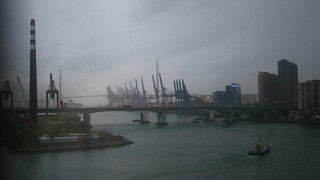 Hong Kong’s airfreight volumes in 2013 will improve slightly over 2012, but maritime freight, which was affected by a strike, will post a decline, according to the latest report from market intelligence provider Business Monitor International (BMI).
Hong Kong’s airfreight volumes in 2013 will improve slightly over 2012, but maritime freight, which was affected by a strike, will post a decline, according to the latest report from market intelligence provider Business Monitor International (BMI).
BMI’s “Hong Kong Freight Transport Report Q4 2013″ predicts that airfreight tonnage growth for this year will be 2.4 percent after a growth of 2.2 percent in 2012.
It said the launch by Cathay Pacific Cargo, the freight-carrying wing of the Hong Kong flag carrier, of a twice weekly freighter service between Hong Kong and the Mexican city of Guadalajara will help boost the country’s airfreight volumes in the coming years.
On the other hand, throughput at the Port of Hong Kong is forecast to decrease by 4.5 percent in 2013 year-over-year, hindered by a 40-day strike.
The strike at the port may have ended in April 2013, but the throughput declines at the port have not stopped, noted BMI. The latest data show a 10.5 percent fall in May and a 3 percent decrease in June year-over-year.
“The declines highlight that the problems that the port of Hong Kong faces go deeper than industrial action,” said BMI.
The study added that Hong Kong’s port and air freight volumes are to benefit from the recovery course being taken by U.S. demand in 2013, as well as from the expected migration of the euro zone financial crisis “from an acute to a more chronic phase.”
The major short-term risk to the outlook for Hong Kong freight is the potential deepening of the slowdown in demand outlook for Europe, the U.S., and China.
“If the mainland economy experiences a sharper-than-expected slowdown, or the sovereign crisis in Europe takes a turn for the worse, it would lead to a slower growth outlook for freight volumes through Hong Kong’s transshipment hubs,” BMI said.
“With Hong Kong’s freight sector and China’s growth so intertwined, the sector will be one of the first in line to be hit should China’s slowing growth develop into a hard landing,” it added.
Another downside risk is to Hong Kong’s transshipment role. This as China becomes less reliant on Hong Kong for its transshipment needs, and as China’s manufacturers move away from the coast into the interior and away from the Pearl River Delta, the region Hong Kong has traditionally catered for.
“As China’s ports and airports are becoming better connected, demand levels are such that shippers are now able to offer freight options directly to Chinese mainland ports and airports rather than transshipping via Hong Kong,” noted the report.
But Hong Kong is expected to fight to retain its role as a transshipment hub for the aviation and maritime sectors. Investment and expansion is being ploughed into the nation’s airfreight and port sectors, with the Cathay Pacific Cargo Terminal opened at Hong Kong International Airport this year and the old runway at the Kai Tak Airport set to be developed into a barge dock.
Photo: namho




